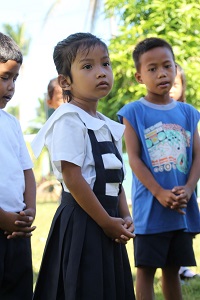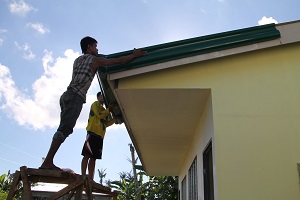First day of school in typhoon-affected areas
Eastern Samar, the second-poorest area in the Philippines, has 112 totally and 317 partially damaged schools. Many of students have to start the new school year under tarps.
As the school year ends in Finland, in the Philippines it starts. Here, the school year starts at the beginning of June and ends at the end of March.
Five-year-old Gellian Maragrag started her very first school day in the Elementary School of San Jose. Her mother brings the small girl to the school gate, and the first-grader walks through the yard to the temporary school building.
San Jose school is situated in Eastern Samar, which is one the areas severely affected by typhoon Haiyan, locally called Yolanda. The roof of the temporary school is made of tarpaulin and walls of coco lumber splinters. It has been built on the foundation of an old classroom, totally damaged by the typhoon.
“It gets very hot in here towards noon,” says teacher Casimira Odeviras.
Everyone is looking forward to having a new classroom.
Soon the small school of 40 students will get three proper classrooms. As Gellian Maragrag and the others kick off the school year with The Lord’s Prayer, the National Anthem and flag raising, finishing touches are being made at the adjacent construction site.
Typhoon blew off the roof of the other school building, but as the building is otherwise okay and safe, it will get a new roof. San Jose will also get a brand new classroom.
Rebuilding 55 classrooms
After the acute phase of the catastrophe, Finn Church Aid (FCA) decided to concentrate its efforts towards supporting education in typhoon-hit areas. The Finnish NGO builds 55 semi-permanent classrooms in Eastern Samar. Hundreds of students will be able to study in proper, weather-resistant buildings.
The construction process has been slow. Heavy rains slowed casting of the foundations. Also the building permits were not easy to obtain. Materials and workforce have been difficult to find in a country that right now is rebuilding after the historically powerful storm.
“At times we have been out of sand, then gravel and then cement. The local construction company has not been able to deliver materials so that the work could have been done without delays,” tells FCA School Construction Coordinator Kari Miettinen.
There are now altogether 16 construction sites. Finn Church Aid has chosen schools which are not receiving assistance for any other NGO’s. Part of the work,such as debris clearing and painting, is carried out as cash-for-work, offering much needed remuneration for parents.
Buildings withstand winds and heat

The school day starts with The Lord’s Prayer, the National Anthem and flag raising. Gellian Maragrag has already learned these in Kinder (preschool).
All schools are situated in poor, remote areas, still clearly in need of assistance. On the way to the school construction sites there are temporary shelters built up using debris and tarps. The worst is over in typhoon-affected areas, but reconstruction is stalling. The reason lies in poverty.
However, clean children in dapper clothes emerge from the shelters. Most are wearing beautiful school uniforms; the boys are in white shirts and dark trousers, the girls in skirts or dresses, the colors varying from school to school.
Although the temperature outside is +35, it is comfortable cool inside the new Finn Church Aid classroom. The materials have been chosen to withstand local weather patterns – the heat, heavy rains and stormy winds. Fiber-cement wall boards withstand heat, fire and mold.
The buildings have a time-span of at least 15 years and by replacing the wall boards, the life-span can be extended. The classrooms will have new desks and chairs and the blackboards will be painter in the walls with blackboard paint.
Text and photos: Ulla Kärki
